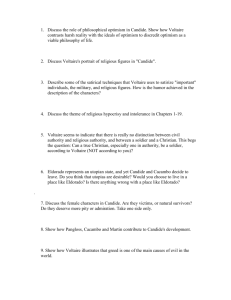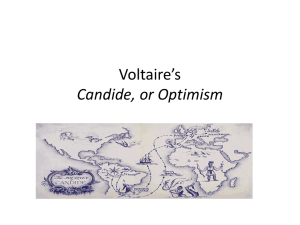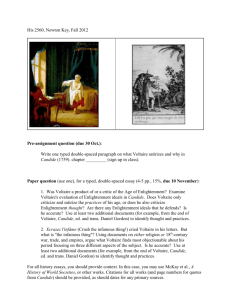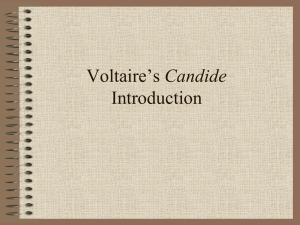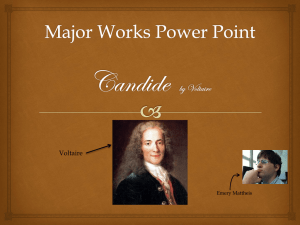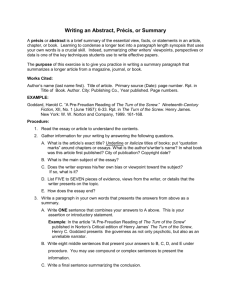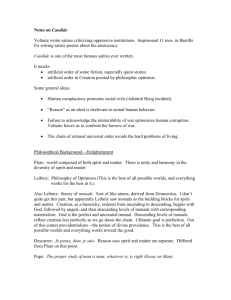(TSoW and Candide and Persepolis)
advertisement
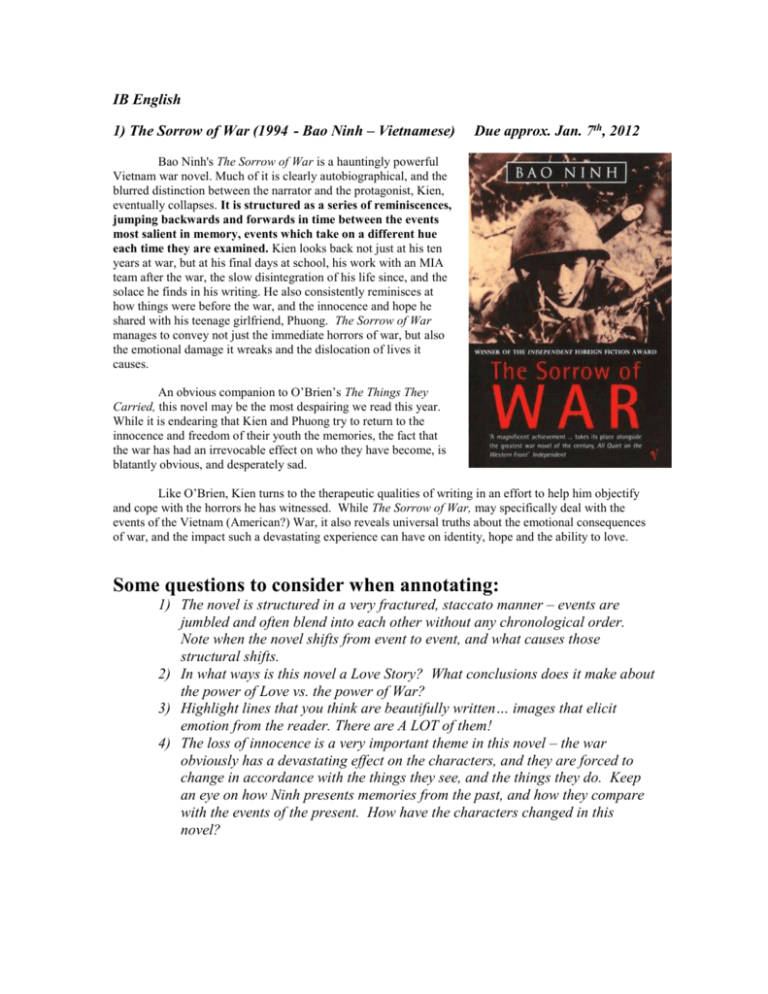
IB English 1) The Sorrow of War (1994 - Bao Ninh – Vietnamese) Due approx. Jan. 7th, 2012 Bao Ninh's The Sorrow of War is a hauntingly powerful Vietnam war novel. Much of it is clearly autobiographical, and the blurred distinction between the narrator and the protagonist, Kien, eventually collapses. It is structured as a series of reminiscences, jumping backwards and forwards in time between the events most salient in memory, events which take on a different hue each time they are examined. Kien looks back not just at his ten years at war, but at his final days at school, his work with an MIA team after the war, the slow disintegration of his life since, and the solace he finds in his writing. He also consistently reminisces at how things were before the war, and the innocence and hope he shared with his teenage girlfriend, Phuong. The Sorrow of War manages to convey not just the immediate horrors of war, but also the emotional damage it wreaks and the dislocation of lives it causes. An obvious companion to O’Brien’s The Things They Carried, this novel may be the most despairing we read this year. While it is endearing that Kien and Phuong try to return to the innocence and freedom of their youth the memories, the fact that the war has had an irrevocable effect on who they have become, is blatantly obvious, and desperately sad. Like O’Brien, Kien turns to the therapeutic qualities of writing in an effort to help him objectify and cope with the horrors he has witnessed. While The Sorrow of War, may specifically deal with the events of the Vietnam (American?) War, it also reveals universal truths about the emotional consequences of war, and the impact such a devastating experience can have on identity, hope and the ability to love. Some questions to consider when annotating: 1) The novel is structured in a very fractured, staccato manner – events are jumbled and often blend into each other without any chronological order. Note when the novel shifts from event to event, and what causes those structural shifts. 2) In what ways is this novel a Love Story? What conclusions does it make about the power of Love vs. the power of War? 3) Highlight lines that you think are beautifully written… images that elicit emotion from the reader. There are A LOT of them! 4) The loss of innocence is a very important theme in this novel – the war obviously has a devastating effect on the characters, and they are forced to change in accordance with the things they see, and the things they do. Keep an eye on how Ninh presents memories from the past, and how they compare with the events of the present. How have the characters changed in this novel? 2) Candide (1759 – Voltaire - French) Due approx. Feb.25th François-Marie Arouet, best known under his pen name Voltaire, is such a historical giant that some scholars, like Ariel and Will Durant, call the eighteenth century the "Age of Voltaire." Voltaire was unrivaled in stature as an author. He criticized everyone and signed his works with "Ecrasez l’infame" or "down with infamy." Though he wrote more than eighty volumes of material, his most popular work remains Candide; ou L'optimisme, traduit de l'Allemand, de Mr. le Docteur Ralph, translated in 1759 as Candide; Or All for the Best. The reception of the work was controversial; in fact, the Great Council of Geneva immediately denounced it and ordered all copies to be burned. Candide parodies the philosophy of optimism put forth by Gottfried Wilhelm von Leibnitz. This philosophy states that since God created the world and God is perfect, everything in the world is ultimately perfect. Voltaire had already attacked this philosophy of optimism in his poem on the 1756 Lisbon earthquake. Rousseau answered the poem with a letter, which was leaked to the press, saying it was Voltaire who was mistaken. Voltaire answered back three years later with the tale of Candide. The tale is a fantastic picaresque journey that takes Candide around the world. After he and his friends are killed, they are brought back to life; first rich, then poor; and finally, they wind up on a farm in Turkey. On the surface level, it is a light-hearted whimsical journey taken by a naïve and open minded hero who travels the world in search of his one true love (Cunegonde). However, on a much more profound level, Voltaire reveals the absurdity of some of our beliefs and constructed meanings, and the ridiculous and implausible extents to which we are willing to go to provide some sense of order to our world. Some questions to consider when annotating: 1) Candide might be the funniest novel we read this year. How does Voltaire express humour through literary elements like tone, writing style, plot and exaggeration? 2) What is endearing about Candide as a character? What is endearing about his quest? 3) What adjectives would you use to describe Pangloss? Find events that support your choices? 4) Were there any inspirational lines/stories that you found memorable? 5) What does Candide learn (if anything) from each of the places he visits? From the people he meets? 6) As mentioned above, Voltaire’s work is mainly a criticism of Leibnitz’ philosophy of Optimism – the belief that everything happens for a good reason according to God’s divine plan. Clearly, Voltaire did NOT agree with Leibnitz, as he goes to great lengths to show how absurd this philosophy is. As you read, pay close attention to events where Voltaire is clearly mocking Leibnitz’ philosophy. 2) Persepolis (2002 – Marjane Satrapi - Iranian) Due approx. Mar. 25 Persepolis is the poignant story of a young girl in Iran during the Islamic Revolution. It is through the eyes of precocious and outspoken nine year old Marjane that we see a people's hopes dashed as fundamentalists take power - forcing the veil on women and imprisoning thousands. Clever and fearless, she outsmarts the "social guardians" and discovers punk, ABBA and Iron Maiden. Yet when her uncle is senselessly executed and as bombs fall around Tehran in the Iran/Iraq war, the daily fear that permeates life in Iran is palpable. As she gets older, Marjane's boldness causes her parents to worry over hercontinued safety. And so, at age fourteen, they make the difficult decision to send her to school in Austria. Vulnerable and alone in a strange land, she endures the typical ordeals of a teenager. In addition, Marjane has to combat being equated with the religious fundamentalism and extremism she fled her country to escape. Over time, she gains acceptance, and even experiences love, but after high school she finds herself alone and horribly homesick. Though it means putting on the veil and living in a tyrannical society, Marjane decides to return to Iran to be close to her family. After a difficult period of adjustment, she enters art school and marries, all the while continuing to speak out against the hypocrisy she witnesses. At age 24, she realizes that while she is deeply Iranian, she cannot live in Iran. She then makes the heartbreaking decision to leave her homeland for France, optimistic about her future, shaped indelibly by her past. Some questions to consider when annotating: 1) In what ways are the themes and events in this novel similar to 1984? 2) In a graphic novel, we obviously get a combination of text and image. Keep a close eye on the images that are used in each frame. How much of the story do they tell? Highlight 5-8 images that are particularly powerful for you. 3) One of the major themes in the novel is Identity. With that in mind, consider what role our surroundings play in our understanding ourselves? (alternately: to what degree do our surroundings define us?) in both the case of Marji, and in your own life? 4) How does Marji change and mature over the course of the novel? In what ways is this a “coming of age” story? Find evidence to support your ideas.
